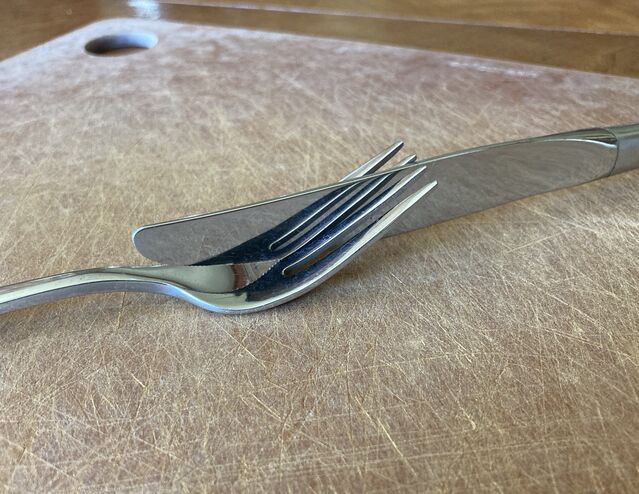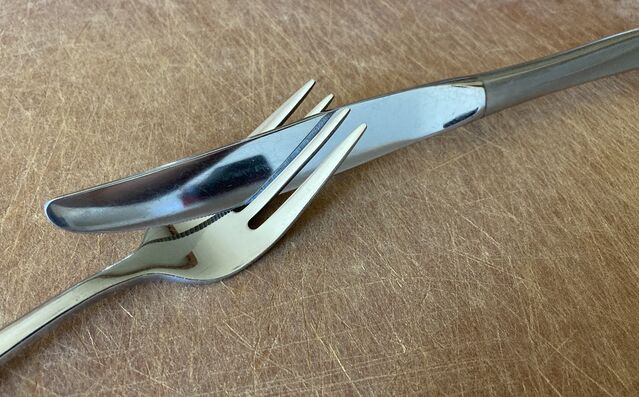Cognition
The Fork-and-Knife Illusion Makes Metal Appear Transparent
Here's a new illusion you can create at the dinner table with silverware.
Posted March 31, 2021 Reviewed by Davia Sills
Key points
- A new paper published in 'Perception' demonstrates a transparency illusion you can create with a fork and knife.
- By placing a metal knife in between the tines of a fork, the knife takes on a transparent appearance.
- Discoveries like this serve as a reminder to stay curious and open to new discoveries in science.
Many times, scientific discoveries emerge after months and years of tedious work in the laboratory. Other times, discoveries occur in the most ordinary situations. In a newly discovered visual illusion, middle-schooler Blaise Balas was playing around with her utensils during dinner and noticed a striking transformation—when she placed the knife vertically between the tines of the fork, the knife suddenly took on a transparent appearance—see the image below.

This is not the first illusion in which a mirrored surface (like a knife) takes on a transparent appearance. For example, research in the 1990s on phantom limbs by V.S. Ramachandran and D. Rogers-Ramachandran found that placing a mirror that occludes one's phantom arm while reflecting the other arm could lead to pain reduction in amputee patients. In this case, the mirror takes on a transparent appearance because of the bilateral symmetry of the human body.
The advantage of the novel Fork-and-Knife Illusion is that you don't need a custom-built mirror box to produce it, but rather two common household items that are already usually found together: a metal fork and knife.
The paper by daughter-and-father duo Blaise and Benjamin Balas published in this month's issue of Perception reports several factors that can affect the strength of the illusion. For example, if the fork is tilted just a few degrees away from perpendicular, the illusion is broken:

In fact, with any change to the position of the knife or to the angle of the photograph itself that leads to the fork's real and reflected tines being misaligned, the illusion is greatly weakened or eliminated entirely.
At the same time, there are some modifications that make the illusion of transparency even stronger. For example, Balas and Balas report that if the surface of the knife is dull or scratched, it produces a more compelling illusion of transparency as compared to a new, shiny knife. They argue that this is because a shiny surface allows one to "see strong specularities along contours in the reflected image that are inconsistent with the appearance of those contours on the real fork" (Balas & Balas, 2021).
There are many questions still to explore about the Fork-and-Knife Illusion, which was also named as a top-10 finalist in this year's Best Illusion of the Year Contest. For instance, I noticed that when I place the knife over the fork, it appears that the entire knife becomes transparent, not just the part that interacts with the fork. Does this transparency transformation happen instantly, or does it happen over a period of time? In other words, does the part of the knife that interacts with the fork become transparent first, with transparency expanding outward toward the handle?
One might also wonder about individual differences in perceiving the illusion. Does the strength of the illusion vary according to the observer's experience with transparent knives—for example, clear, plastic knives?
The novel Fork-and-Knife Illusion is not only a practical visual illusion you can try out at the next (in-person) dinner party but also a reminder that scientific discoveries can happen in the least expected situations. All it takes is some common objects, a playful context, and a keen observer.
References
Balas, B., & Balas, B. (2021). The Fork-and-Knife Illusion. Perception, 0301006620988847.
Ramachandran, V. S., & Rogers-Ramachandran, D. (1996). Synaesthesia in phantom limbs induced with mirrors. Proceedings of the Royal Society of London. Series B: Biological Sciences, 263(1369), 377-386.


